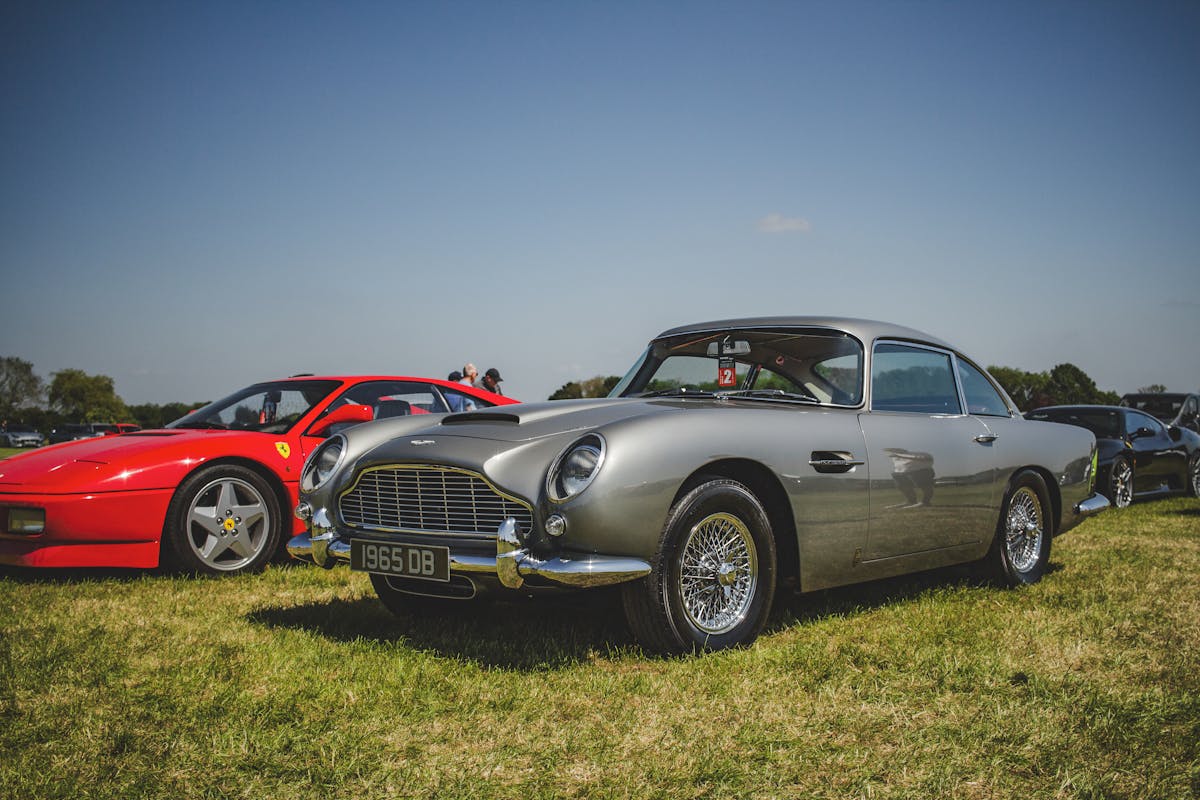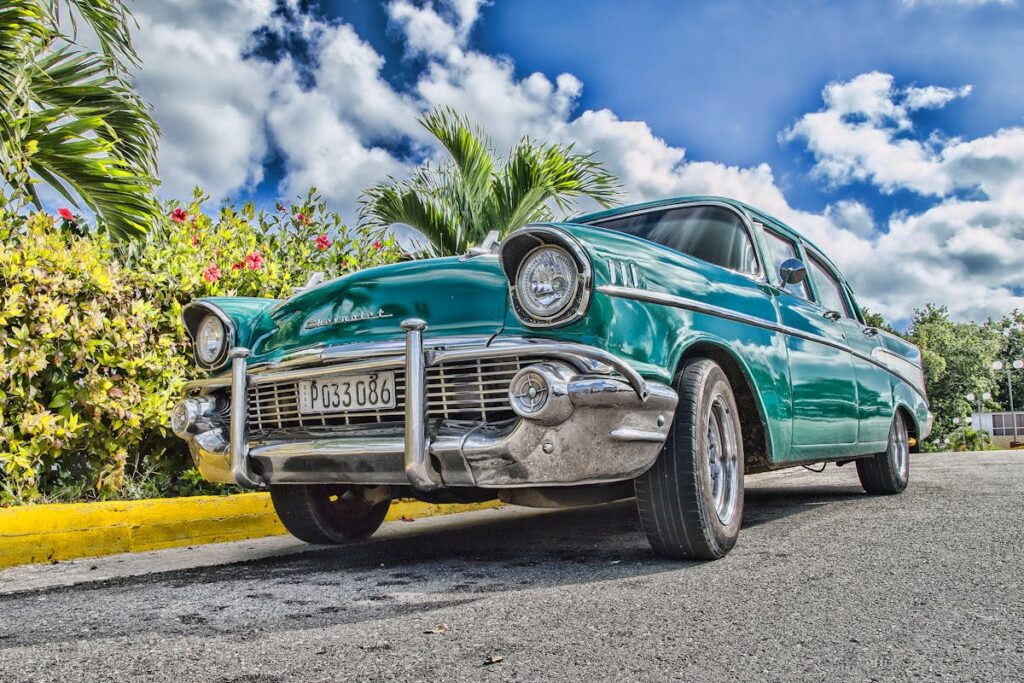In the domain of film and pop culture, classic cars often function as more than mere props, instead embodying symbols of time, personality, and aesthetic. From the sleek Aston Martin synonymous with James Bond to the gritty Ford Mustang GT showcased in “Bullitt,” these vehicles command attention, often becoming as iconic as the films and characters they represent. As these classic automobiles bridge the gap between past and present, we invite you to explore their significant influence on fashion, lifestyle, and the broader cultural landscape.
Iconic Cars in Hollywood Blockbusters
While many may not immediately recognize the importance, it is undeniably true that iconic cars have played pivotal roles in Hollywood blockbusters, often becoming as memorable as the characters themselves. The classic car chases, often a staple in action and thriller genres, are made even more impactful due to these vintage vehicle appearances.
The 1968 Ford Mustang GT in “Bullitt,” for instance, was not only integral to the plot, but its presence in the film’s groundbreaking car chase scene left a lasting imprint on cinematic history. Similarly, the 1970 Dodge Charger in “The Fast and the Furious” franchise became synonymous with Vin Diesel’s character, embodying his personality, spirit, and underlying storylines.
These iconic cars have not only contributed to the visual appeal of films but have also played a significant role in setting the overall mood, tone, and atmosphere. Their importance is further magnified in period films, where they provide an authentic representation of the era, enhancing the film’s credibility and immersing the audience in the narrative.
The Role of Classic Cars in Character Development
Undeniably, classic cars in movies often play a significant role in character development. The car personality serves as an extension of the character’s identity representation, providing subtle hints about their traits and personal history. Vintage aesthetics contribute to the nostalgic influence, evoking a sense of a bygone era, which can further enrich the character’s backstory and emotional connection with the audience.
The automotive traits of a classic car, such as its make, model, color, and condition, can reflect the character symbolism. For instance, a well-maintained, sleek, high-end classic car may suggest a character’s wealth, status, or meticulous personality. Conversely, a battered, rusty model might indicate a tough, resilient character who has weathered many storms.
Moreover, the cultural significance of classic cars can’t be overlooked. The choice of car can indicate a character’s cultural background, social class, or even generation, hence making them more relatable and authentic. Classic cars, consequently, are more than just vehicles in movies; they are pivotal tools for character development, subtly conveying volumes about the characters’ persona, their past, and their emotional landscape.
James Bond and His Aston Martin
In the vast domain of cinematic history, few relationships are as iconic as that between James Bond and his Aston Martin, a classic car that has become a signature symbol of the 007 franchise. The evolving design and technological features of Bond’s Aston Martin reflect not only the changing times, but also the evolving persona of Bond himself. A detailed analysis of the Aston Martin’s presence and action in the film series not only underscores its role as a key cinematic tool but also its prominence in shaping the character and narrative of the world’s most famous spy.
Bond’s Iconic Aston Martin
The world of cinema and the automobile industry share a storied history, and no car has been more iconic or recognizable than James Bond’s Aston Martin. This classic design is not just a vehicle but a symbol of Bond’s gadgets, performance legacy, and a representation of Aston aesthetics. The Aston Martin, a quintessential part of the Bond cinematic legacy, is synonymous with thrilling car chases set to iconic soundtracks. Its global appeal is undeniable and has played a pivotal role in making the Bond franchise a household name across continents.
- The Aston Martin’s sleek design and advanced features, often laden with Bond’s gadgets, add a layer of intrigue to the franchise.
- Its distinctive sound, a blend of engine roar and tire squeal, is an integral part of the iconic soundtracks that accompany Bond’s thrilling car chases.
- The Aston’s aesthetic is a classic design that has remained relevant and coveted, contributing to its performance legacy.
- Its global appeal transcends barriers, making it a universally recognized symbol of sophistication, speed, and the thrilling world of espionage.
Evolution of 007’s Car
While the Aston Martin has become a defining emblem of the Bond franchise, its evolution throughout the series is a narrative of its own, charting the technological advancements and changing tastes in the automobile industry. Over the years, the car has gone through various transformations, each adding a new layer of sophistication and intrigue to Bond’s character.
In the early films, the Aston Martin was a stylish but relatively simple vehicle. However, as Bond’s gadgets became more sophisticated, so did his car. The addition of an ejection seat in Goldfinger was a defining moment, marking a shift towards a more gadget-laden vehicle. It was also the beginning of the car becoming a central part of the thrilling car chases that the series would become known for.
The evolution of 007’s car also reflects the changing tastes in the automobile industry. From the classic DB5 to the sleek and modern DBS, the Aston Martin models used in the series have mirrored the trends in car design, from the elegant simplicity of the 60s to the high-tech sophistication of the 21st century. This evolution not only adds depth to the Bond character but also gives a nod to the changing times in our own world.
Aston Martin in Action
Shifting the lens from the car’s evolution in the Bond series, we now turn our focus to the Aston Martin in action. The Aston Martin has indeed established a legacy that transcends the Bond series, becoming an embodiment of style, power, and sophistication in popular culture.
To truly appreciate the Aston Martin’s impact, let’s dissect some of its most notable features and appearances:
- The Aston Martin DB5, first introduced in “Goldfinger” (1964), became a pop culture icon with its armoured body, revolving license plate, and ejection seat.
- The Aston Martin V8 Vantage, seen in “The Living Daylights” (1987), was equipped with rockets, lasers, and a self-destruct system, showcasing the brand’s innovation.
- The Aston Martin DBS, featured in “Casino Royale” (2006) and “Quantum of Solace” (2008), highlighted the car’s elegance and power, reinforcing the Aston Martin legacy.
- Finally, the state-of-the-art DB10, custom-made for “Spectre” (2015), emphasized the brand’s commitment to future advancements, while staying true to its classic aesthetics.

Symbolic References of Classic Cars in Movies
Countless times in cinematic history, classic cars have been used as symbolic references, signifying a variety of underlying themes and character traits. The cultural significance of these automobiles often transcends the screen, embedding themselves in the collective psyche as symbols of a bygone era, their nostalgia factor resonating with audiences worldwide. Their aesthetic appeal lends a visual richness to the scenes they adorn, while their role as status symbols reflects the socio-economic standing of characters.
Classic cars also serve as a storytelling device, their presence often indicating an emotional connection between characters and their pasts. The 1961 Ferrari 250GT California from “Ferris Bueller’s Day Off”, for instance, encapsulates the strained relationship between a father and son, the car being a symbol of unattainable expectations.
Moreover, the historical context of these cars provides a sense of authenticity and grounds the plot in a specific time period. Consider the 1976 AMC Pacer in “Wayne’s World” – its uncool status perfectly embodies Wayne and Garth’s down-to-earth charm.
Impact of Classic Cars on Pop Culture Trends
Over the years, the influence of classic cars on pop culture trends has been profound and multifaceted. The cultural significance of these vehicles extends beyond their primary function of transportation; they are time capsules, embodying the nostalgia factor of bygone eras, and their automotive design reflects the historical context of their times.
Classic cars, with their vintage appeal, have often been used as a symbol of social status in movies, thereby influencing fashion, lifestyle, and consumer trends. The cinematic aesthetics of these cars, combined with clever marketing strategies, have further catapulted their popularity and desirability, reinforcing their iconic status in pop culture.
To paint a clearer picture, consider the following instances:
- Classic cars like the Aston Martin DB5 in James Bond films have become synonymous with luxury and sophistication, influencing lifestyle choices and consumer behavior.
- The 1968 Ford Mustang GT from ‘Bullitt’ has notably influenced automotive design trends, inspiring a new generation of muscle cars.
- The Volkswagen Beetle, popularly known as ‘Herbie’, has become a cultural icon, representing innocence and adventure.
- The 1959 Cadillac Miller-Meteor, famously known as the ‘Ghostbusters’ car, has spawned countless memorabilia and collectibles, demonstrating the powerful impact of marketing strategy.
Classic Cars in Animated Movies and Series
Shifting our focus to the domain of animation, classic cars have played pivotal roles in the narratives of numerous animated movies and series, becoming iconic figures in their own right. The evolution of automotive representation in animation has mirrored the progress of automobile design in the real world, adding a layer of authenticity to these animated creations. Furthermore, the characterization of these cars often imbues them with personalities that resonate with audiences, making them as memorable as their human counterparts.
Iconic Animated Cars
In the domain of animated cinema, the presence of classic cars is not merely a charming accessory, but often a central character in the storyline. These vehicles, personified with unique traits and quirks, become unforgettable characters in their own right. Consequently, animated classics have provided an avenue for car personalities to take center stage, influencing pop culture considerably.
- The anthropomorphic 1963 Volkswagen Beetle, “Herbie,” from Disney’s “The Love Bug,” captured hearts with its endearing personality and comedic antics.
- Pixar’s “Cars” franchise introduced an entire world of vehicle characters, led by Lightning McQueen, a charismatic and determined race car.
- “Speed Buggy,” a Hanna-Barbera animated series in the 70s, showcased an orange dune buggy with a mind of its own.
- In the world of Japanese Anime, “Speed Racer’s” Mach 5 became an icon, embodying the sleek, futuristic vision of automotive design.
These classic cars, each with their distinct personalities, have shaped the landscape of animated entertainment. Their memorable designs, coupled with the life-like characteristics they are given, have made them timeless symbols in both the world of animation and car culture. The impact of these iconic animated cars cannot be overstated as they continue to inspire automotive design and pop culture narratives.
Animation’s Automotive Evolution
Continuing our exploration of classic cars in animation, we can observe an interesting trajectory in the portrayal of such vehicles throughout the years. The evolution of animated vehicles has been marked by an increase in complexity and detail in cartoon car designs, fueled by advancements in animation artistry. This has allowed for a more intricate depiction of classic car characters, transforming them from mere props to key players in the narrative.
In the early days, whimsical automobiles were often simple and exaggerated, serving primarily as comedic elements. However, as animation techniques evolved, so did the depiction of vehicles, many of which began to reflect real-life models, adding a nostalgia factor for older viewers. This meticulous attention to detail not only elevated the visual appeal of these vehicles but also enhanced the storytelling through vehicles, cementing their cultural significance.
In essence, the animation’s automotive evolution has been a demonstration of the ever-evolving animation artistry. The timeless charm of classic car characters and the nostalgia they evoke continue to resonate with audiences, proving that vehicles in animation are more than mere props; they are integral elements of the narrative, with their own stories to tell.
Notable Car Characterization
Delving into the domain of notable car characterization, we observe a fascinating assortment of classic cars that have been brought to life in animated movies and series. This sphere of animation has creatively tapped into the vintage appeal of classic cars, imbuing them with unique car personalities that evoke cinematic nostalgia and resonate with audiences of all ages.
- The 1963 Volkswagen Beetle, famously known as Herbie, exudes an endearing personality that embodies automotive symbolism, illustrating that even the most unassuming vehicle can possess the driving dreams of a champion.
- The 1951 Hudson Hornet from Pixar’s Cars series effectively encapsulates the retro aesthetics of a bygone era, its character, Doc Hudson, becoming a beacon of wisdom and cultural significance in the narrative.
- The Mystery Machine from Scooby Doo, with its distinctive psychedelic colors and hippie vibe, is a classic van that serves as a mobile home for our heroes, creating a sense of film nostalgia.
- Finally, the Autobots in the Transformers series, though futuristic, offer an intriguing blend of vintage appeal and high-tech allure, showcasing the versatile power of car characterization.
These examples demonstrate how animation has leveraged classic cars as a vehicle for storytelling, merging film nostalgia, cultural significance, and automotive symbolism into engaging car personalities.
How Classic Cars Influence Fashion Trends
Often overlooked, the impact of classic cars on fashion trends is undeniable and considerable. These automotive marvels have more than just a nostalgic appeal; they have deeply influenced retro fashion, successfully bridging the gap between the garage and the runway.
The vintage style and design aesthetics of classic cars have a timeless appeal that has often been replicated in fashion. The sleek lines, bold colors, and chrome accents have found their way into clothing designs, jewelry, and accessories. The cultural significance of these iconic vehicles resonates with fashion designers who use them as a source of inspiration, creating fashion statements that echo the elegance and sophistication of the automotive era they represent.
The automotive influence is not just limited to the high fashion world. Even street style has been notably impacted by the classic car culture. From leather jackets inspired by car seats to t-shirts emblazoned with car logos, the love for classic cars permeates our wardrobe choices. Essentially, the nostalgic trends set by classic cars have a continuous, profound impact on the evolution of fashion, underscoring their enduring cultural influence.
Memorable TV Shows Featuring Classic Cars
While the influence of classic cars on fashion trends is a fascinating exploration, another intriguing facet is their prominence in popular television shows. These emblematic vehicles enrich the visual storylines, enhance the retro aesthetics, and contribute to creating memorable scenes.
Classic sitcoms often feature vintage rides, utilizing their nostalgic designs to evoke a specific era or to reflect a character’s personality. The road trips and car chases that these vehicles partake in are essential to the plot, driving the narrative while also adding excitement and tension.
To better illustrate, consider the following examples:
- Supernatural: The 1967 Chevrolet Impala, an emblem of the show, symbolizes the bond between the main characters.
- Mad Men: The vintage cars in this drama series are carefully chosen to reflect the period and the characters’ status.
- Knight Rider: The talking car, K.I.T.T., is not only a classic vehicle, but also a central character.
- The Dukes of Hazzard: The 1969 Dodge Charger, known as General Lee, features in many exciting car chases.
These shows, and many more, demonstrate how classic cars play crucial roles in television, resonating with audiences and becoming cultural icons in their own right.
Frequently Asked Questions
What Is the Most Expensive Classic Car Ever Sold From a Movie Set?
The 1961 Ferrari 250GT California, an iconic vehicle from “Ferris Bueller’s Day Off,” holds the auction record as the most expensive movie car ever sold, exemplifying the high value of automobiles with cinematic history.
How Are Classic Cars Maintained and Preserved for Film Shooting?
Classic cars are meticulously maintained for film shooting through careful restoration techniques and vintage modifications. These processes guarantee their original aesthetic is preserved, while also enhancing their functionality and durability for demanding on-screen performances.
Which Classic Car Has Made the Most Appearances in Movies and TV Shows?
The Ford Mustang, one of the most iconic models, holds a prominent place in cinematic history, having made the most appearances in movies and TV shows, showcasing its timeless appeal and cultural significance.
Are There Any Special Insurance Requirements for Using Classic Cars in Movies?
Yes, specific insurance policies are needed for classic cars used in filming. These cover potential damage or loss during production. Filming regulations also require proof of such insurance before permitting use of these vehicles on set.
Whats the Process for Acquiring Classic Cars for Movie Production?
Acquiring classic cars for movie production involves a thorough process of car sourcing from private collections, vintage auctions, or specialized dealerships, often requiring negotiations and adherence to specific legal and insurance requirements for usage and transportation.

